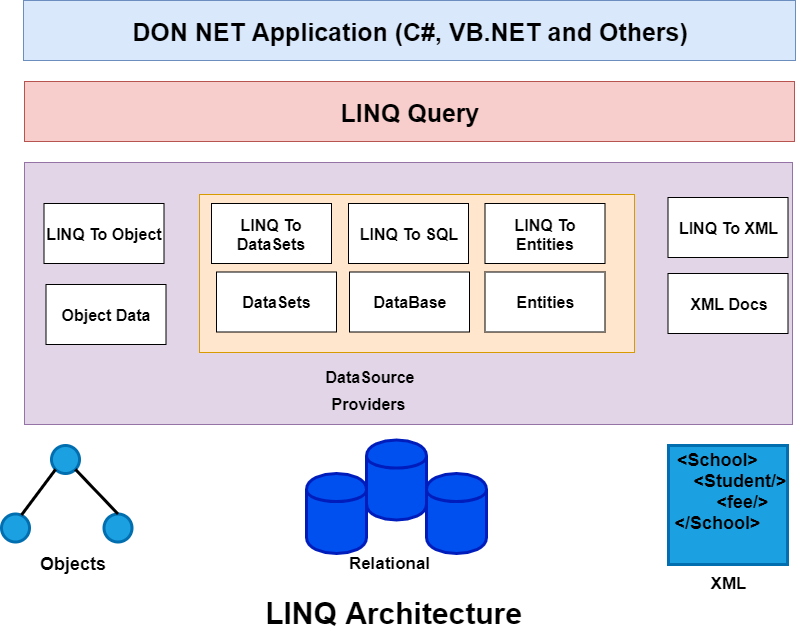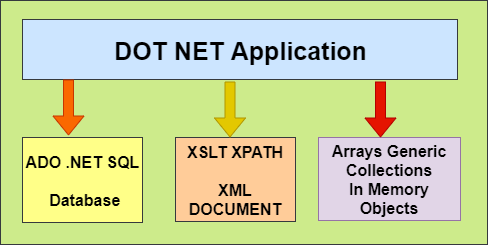LINQ Introduction
Here, we will learn the introduction of LINQ, what is the LINQ in C#/asp.net, why we use LINQ in C#/asp.net, LINQ architecture, Advantage and Disadvantage of LINQ.
What is LINQ
The full form of LINQ is ‘Language Integrated Query,’ and introduced in .NET Framework 3.5 to query the data from different sources of data such as collections, generics, XML documents, ADO.NET Datasets, SQL, Web Services, etc. in C# and VB.NET. LINQ provides the rich, standardized query syntax in a .NET programming language such as C# and VB.NET, which allows the developers to interact with any data sources.
In C# or VB.NET, LINQ functionality can be achieved by importing the System.Linq namespace in our application. Generally, the LINQ contains a set of extension methods which allows us to query the source of data object directly in our code based on the requirement.
LINQ Architecture

This is the architecture of the LINQ, as we know that we can develop the application in .NET. Similarly, the LINQ programming can return the any above mentioned .NET programming language. Between the actual LINQ query and the underlying data source, there is another component also present, known as LINQProvider.
Provider
The responsibility of the LINQ provider is to convert the LINQ Query into a format so that the data source can understand it.
Example: Here, we will take a scenario, let us say the application wants to fetch the data from SQL Database. In this case, LINQ Query will fit into the LINQ to SQL Provider. In this case, it will convert the LINQ Query into T-SQL so that the underlying database can understand in the same way if there is a need to fetch the data from the XML document. We will use the same LINQ query in this case as well, which is LINQ to XML Provider. XML provider would convert the LINQ query into XLST so that the XMLDataSource can understand.
LINQ Objects
As we mentioned in the above diagram, we have different types of LINQ Objects available in C# and VB.NET.
- LINQ To Objects
- LINQ To DataSets
- LINQ To SQL
- LINQ to XML
- LINQ To Entities
Need of LINQ
LINQ is simpler, ordered, and higher-level than SQL. When we want to use Querying Database, in most cases, LINQ is a more productive query language than SQL.
Also, we have the benefits of IntelliSense as the LINQ query is written in behind the code. LINQ has full type checking at compile time so that we can catch any error in compile time itself. In C# or VB.Net to write the query in LINQ is more fun.
Here, we are taking an example of developing a .NET application, and that application requires data from different data sources.
- Suppose the application needs the data from SQL Server Database. So, as a developer, to access the data from SQL Server Database, we need to understand ADO.NET and SQL Server-specific syntaxes. If the database is Oracle, then there is a need to understand the SQL Syntax, which is specific to Oracle Database.
- The application also needs the data from an XML document. So, as a developer to work with an XML document, we need to understand the XSLT and XPath queries.
- In the application, there is also a need to manipulate the data (objects) in memory such as List, List, etc. So, as a developer, there is a need to understand how to work with in-memory objects.
LINQ provides the Uniform Programming Model (i.e., familiar query syntax). It allows us to work with different data sources by using a standard, or in a unified coding style. Hence, we don’t require to learn the different syntaxes to query for various data sources.

LINQ also has some Advantages and Disadvantages as well they are:
Advantages of LINQ
In our applications, the benefits of LINQ are:
- We do not need to learn new query language syntaxes for different sources of data because it provides the standard query syntax for the various data sources.
- In LINQ, we have to write the Less code in comparison to the traditional approach. With the use of LINQ, we can minimize the code.
- LINQ provides the compile-time error checking as well as intelligence support in Visual Studio. This powerful feature helps us to avoid run-time errors.
- LINQ provides a lot of built-in methods that we can be used to perform the different operations such as filtering, ordering, grouping, etc. which makes our work easy.
- The query of LINQ can be reused.
Disadvantages of LINQ
Disadvantages of LINQ are:
- With the use of LINQ, it’s very difficult to write a complex query like SQL.
- It was written in the code, and we cannot make use of the Cache Execution plan, which is the SQL feature as we do in the stored procedure.
- If the query is not written correctly, then the performance will be degraded.
- If we make some changes to our queries, then we need to recompile the application and need to redeploy the dll to the server.
